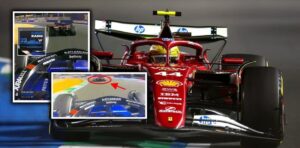Just in:FIA Announces Key 2025 Rule Changes in F1: DRS Tweaks and …read more

FIA Announces Key 2025 Rule Changes in F1: DRS Tweaks and …read more
The FIA has unveiled a series of important rule changes ahead of the 2025 Formula 1 season, as part of a meeting of the World Motorsport Council in Rwanda. The announcements, made during the sport’s governing body’s annual awards ceremony, have sent ripples through the motorsport community, as they promise to impact both race strategy and driver safety in the near future.
The 2025 season is already shaping up to be one of the most eagerly anticipated in recent F1 history. The biggest story is the move of seven-time world champion Lewis Hamilton, who will leave Mercedes for Ferrari in what will likely be his last chance at winning an unprecedented eighth World Championship. Hamilton’s move has set off a domino effect, with several notable driver changes. Carlos Sainz will head to Williams, Nico Hulkenberg will join Sauber, and a fresh wave of youthful talent is emerging, including Kimi Antonelli at Mercedes and Ollie Bearman at Haas.
While these driver moves are taking the spotlight, the FIA has focused on making some critical adjustments to the technical regulations for the 2025 season. These changes, particularly those regarding the Drag Reduction System (DRS) and driver cooling, aim to improve both the competitiveness and safety of the sport.
DRS Slot Gap Reduction
One of the key rule changes centers around the Drag Reduction System (DRS). The FIA has decided to reduce the minimum gap allowed in the rear wing slot when DRS is closed. The new regulations stipulate that the gap will be reduced to a range of 9.4 to 13mm, a change that addresses concerns over aerodynamic performance and fairness. The move is designed to prevent any repeat of the controversy that surrounded the Azerbaijan Grand Prix, where McLaren’s innovative use of a ‘mini DRS’ system sparked heated debate.
The ‘mini DRS’ controversy occurred when McLaren introduced a new interpretation of the rear wing design, which allowed the slot to open slightly more than other teams’ wings. While legal under existing rules, the situation raised questions about the fairness of the design and the potential for teams to gain significant advantages under DRS activation. By tightening the minimum gap for the closed position, the FIA aims to create a level playing field for all teams and eliminate any ambiguities in the interpretation of the regulations. This adjustment will ensure that teams cannot exploit minor loopholes to gain an unfair advantage.
The DRS system, which allows drivers to temporarily reduce aerodynamic drag and increase their straight-line speed to facilitate overtaking, has become a key feature of F1 racing. With this new change, the FIA hopes to improve the system’s effectiveness, ensuring that it continues to promote competitive racing while maintaining strict technical consistency across all teams.
Mandatory Driver Cooling Kits
In addition to the DRS regulation changes, the FIA has also addressed concerns related to driver safety in extreme weather conditions. New driver cooling kits were introduced earlier to help combat the physical stresses that drivers endure, especially in hot conditions. However, these cooling kits add weight to the car, which raised concerns about their potential impact on the overall performance of the vehicles.
After careful evaluation, the FIA has clarified that the cooling kits will be mandatory under certain conditions. Specifically, the kits must be used when a race director calls a ‘heat hazard’ or when the official FIA weather radar predicts that temperatures will exceed 30.5°C. This ruling aims to ensure that drivers are adequately protected from heat-related issues, which can lead to dehydration, exhaustion, or even fainting during races in extreme conditions.
The introduction of mandatory cooling kits reflects a growing emphasis on driver safety, particularly as F1 races are often held in some of the hottest climates, including locations like Bahrain, Singapore, and Abu Dhabi. In these environments, maintaining optimal driver health is critical to ensuring their ability to perform at the highest level while mitigating the risk of heatstroke or other heat-related illnesses. The cooling kits are designed to regulate the body temperature of the driver, helping to keep them comfortable and safe during long, physically demanding races.
Looking Ahead to 2026
These changes for the 2025 season are seen as a precursor to the more significant regulation changes that will be implemented for the 2026 season. While the FIA has yet to finalize the full scope of the 2026 changes, it is expected that the sport will see even greater shifts in technical and sporting regulations. The focus will likely be on further improving car sustainability, enhancing safety features, and fine-tuning the balance between performance and cost control.
As the countdown to the 2025 season begins, the FIA’s recent rule tweaks indicate their commitment to addressing both competitive fairness and driver welfare. With driver changes already causing significant excitement, these new regulations will only add another layer of intrigue as teams prepare for what promises to be a thrilling and competitive season ahead.
In conclusion, the FIA’s rule changes for 2025 — focused on DRS adjustments and mandatory driver cooling kits — show the governing body’s continued commitment to ensuring the sport evolves in a way that is fair, safe, and sustainable. As the 2025 season looms large, fans and teams alike will eagerly anticipate the impact of these changes on the track.





